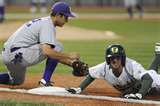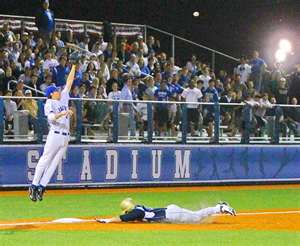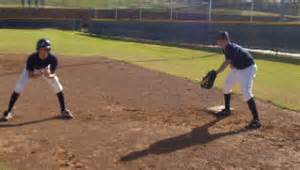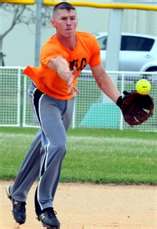Baseball Fielding Drills - Playing First Base
When teaching Baseball Fielding Drills pertaining to first base my first goal is to dispel the belief “ You have to be a left hander to play first base.”
Conventional thinking reasoned a left handed thrower could throw the ball to second base quicker than a right hander because throwing across his body was a natural action for him. Since he wouldn’t have to reconfigure his body, by shifting his feet and hips, in order to throw to second, meant a quicker throw to second in order to force a lead runner.
Better coaching, which taught quicker foot movement resulting in split second reaction time for the right hander to convert into throwing position has proven a left hander has no distinct advantage over a right hander when it comes to playing first base.
As a matter of fact, major league baseball now considers playing first base a matter of insuring an extended playing career for older players. For example, Johnny Bench, a hall of fame inductee as a catcher, reached the age which he could not physically play the catcher’s position on a daily basis.

Baseball Fielding Drills - Quick Tag
Instead of being forced to reduce his playing time or retire, he was moved to first base where he continued to be a very productive hitter long past his catching career.
All-Star players, such as Albert Pujos and Prince Fielder, are now intentionally positioned at first base with the intentions of them playing their entire career at the position.
Physical Qualities:
A player with Height is a nice thing, as it affords the other infielders a larger target to throw at, but height, unless the player is extremely short, is more of a feather that tips the scale between two players of equal skill level.
A first baseman must have what they call Soft Hands, which is rather difficult to scientifically explain what makes soft hands, but soft hands is the ability to catch, or cradle, the baseball pretty well anywhere it’s thrown. ---- Baseball Fielding Drills
When I asked numerous coaches what they thought made a “soft handed” player the general consensus was it was a God given talent, but could otherwise be enhanced with practice. Since I don’t know either so I’ll bow to consensus.
However, like I said, should a player not be born with this talent he needn’t despair. Practice, practice and practice will turn any player into a “Sure Handed” fielder, which any coach will take in a heartbeat.
A first baseman must have nimble and quick footwork, as the first baseman is sort of treated like the “ Red Headed Stepchild” by his fellow fielders. They’ll bounce the ball to him, try to throw it over his head, and throw the ball wide, pulling him off the base.

Baseball Fielding Drills
First Job - Catching The Ball
In spite of all this, he’s expected to catch the ball cleanly while maintaining contact with the base. Worse case scenario is to be pulled off the base, but still tag the runner before he reaches safely. Obviously this little twist & shout routine requires quick feet which move without conscious effort by the player.
Foot Placement: Baseball Fielding Drills
Younger or ill coached players will have a tendency to want to place their foot on the base while waiting for the throw. If you teach the first baseman nothing else this season, teach him not to put his foot on the base, but against the base. ---Baseball Fielding Drills
Two reasons:
One, his foot on the base will absolutely, sooner or later, result in a severe injury due to the base runner stepping on the foot or ankle!
Two, by placing his foot against the side of the base he has the ability to move to an errant throw and affords him the ability to be able to push off the base in order to stretch for the throw in a close play situation.

Baseball Fielding Drills- Look At Foot Placement
Positioning:
Field Positioning of the first baseman will be determined by various factors such as, runners on or not, inning, bunt situation, score and several other factors.
The normal, regular fielding position for the first baseman is @ 10’ - 15’ off the base and @ 10’ - 15’ back from that spot, this is assuming 90’ bases otherwise adjust accordingly to base length )
Should your first baseman not be able to quickly reach the base, adjust accordingly. You may have to sacrifice defensive range in order to have a sure handed first baseman, or a powerful bat in the lineup.
Fielding:
Upon the crack of the bat, and seeing that the ball is not hit in his direction, the player dashes to first base and prepares to take the throw from the fielder. --- Baseball Fielding Drills
He faces the throwing fielder while touching the base with the back of his heel, which practice will teach the player placement and distance of his beginning foot work without having to look or think about it.
As he sees the throw coming toward him he must analyze ( practice, practice, practice ) what he must do in order to catch the baseball and maintain contact with the base.
If the throw is wide left, he moves left shifting his feet to where his right foot maintains contact against the base. Same if the throw is wide right, he moves right shifting his foot to where his left foot maintains contact with the base. --- Baseball Fielding Drills

Baseball Fielding Drills- Better Be Flexible
The hardest play for the first baseman to make is the wide and high throw from an infielder. If the throw is high and wide left, he must break contact with the base, leap into the air catching the ball and swing his arm towards the runner, hopefully tagging him on the shoulder for the out, as he comes back down. Obviously, much easier said than done.
I always taught my first baseman to stretch, but not fully, towards the ball even if it’s a perfect throw. The more familiar he becomes with stretching the more instinctive it will become, and if he’s accustomed to half a stretch, the fully extended stretch won’t feel like he’s falling down or is off balance.
When holding runners on, the normal positioning for the feet is:
1. The Right side of the Right foot pressed against the Front Side, the side you approach when running down the baseline, the left foot on the foul line or within it…. OR
***The Keith Hernandez rule forbids you from being in foul territory. ***
2. Your Right Heel touches the infield corner of the base, the corner facing the pitcher, your left foot inside the foul line, your body is slightly angled towards second base. -- Baseball Fielding Drills
****A little tip here for enhancing first base play.**** A rubber ball or tennis ball can quickly become an infielders best friend. By bouncing the ball against a wall, the player can practice anything he wishes, short hops, moving left and right or catching balls hit over your head, literally fielding hundreds of balls an hour…all by himself.
Holding Runners Close:
It’s a well established fact, base runners steal off of the pitcher, by them either not paying attention to the runner, having a very slow move to the plate when pitching or not developing a good pick off move. In any event, it’s the first baseman’s job to help the pitcher hold runners close, enabling the catcher a chance to throw him out.

Baseball Fielding Drills- Soft Toss When Close
You should literally pretend you’re a catcher, giving the pitcher a constant, low target with your glove. Some pitchers can not accurately throw without a target, so it’s important you provide a good one.
By having your glove low, you’ll be able to catch the pick off throw and quickly swipe tag backwards Low where the base runner’s foot or hand will be located as they come back to the base.---Baseball Fielding Drills
Once the pitcher begins his motion to throw to the plate, you must quickly move off the base, by shuffle steps, into a fielding position. It’s important to get off your “Holding” position as quick as possible in order to field as much territory as possible, but don’t get caught being fooled by your pitcher and be moving off the bag as he throws over.
Throwing to the Pitcher:
It’s not uncommon for the first baseman to field a ball far to his right or very deep, which once fielded he’d have no chance of being able to outrun the hitter to the base. In this situation it is the pitcher’s job to cover first base and receive the throw from you.
Depending on many variables, you must slightly lead the pitcher, that is throw the ball ahead of him so he can be running and catch the ball in front of him, stepping on the base.
You must quickly analyze how hard to throw the ball, as you don’t want to “Handcuff” the pitcher by throwing the ball too hard. The best method is to under hand the toss. --- Baseball Fielding Drills
The first baseman has the identical responsibilities as the third baseman regarding foul territory coverage.
Baseball Fielding Drills To How To Play Infield

New! Comments
Have your say about what you just read! Leave me a comment in the box below.